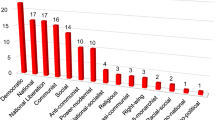Abstract
THE thesis which it is proposed to outline here embodies the following propositions: (1) Available evidence points to Mesopotamia as the oldest known centre of scientific observation permanently recorded. (2) Whatever its immediate objectives, this activity comes to include such widely separated fields as education and language study, jurisprudence, and the mathematical and natural sciences. (3) The numerous elements in this broad advance are interrelated basically. The common underlying factor to which the initial impetus can be traced is a concept of society whereby the powers of the State are restricted and the rights of the individual receive a corresponding emphasis. (4) It is significant that under the opposite social system of totalitarian Egypt early scientific development differed in scope as well as in degree; while notable in certain special fields, such as medicine and engineering, it lacks the breadth and balance manifested in contemporary Mesopotamia.
This is a preview of subscription content, access via your institution
Access options
Subscribe to this journal
Receive 51 print issues and online access
$199.00 per year
only $3.90 per issue
Buy this article
- Purchase on Springer Link
- Instant access to full article PDF
Prices may be subject to local taxes which are calculated during checkout
Similar content being viewed by others
References
These facts are brought out clearly by A. Falkenstein, whose "Archaische Texte aus Uruk" (Berlin, 1936) is the basic work on the earliest documents from Mesopotamia; cf. especially pp. 43 ff.
Careful observation is evidenced also by the accurate drawings of the early pictographs, particularly where exotic animals and specific plants were concerned.
See Benno Landsberger (in co-operation with I. Krumbiegel), "Die Fauna des alten Mesopotamien" (Leipzig, 1934).
On this subject see R. Campbell Thompson, "A Dictionary of Assyrian Chemistry and Geology" (Oxford, 1936).
R. Campbell Thompson and C. J. Gadd, in Iraq, 3, 87 ff. (1936).
Cf. E. A. Speiser, "The Beginnings of Civilization in Mesopotamia," J. Amer. Oriental Soc., Supp. 4, 59, 17 ff., esp. 25–28 (1939).
See H. Frankford, "Cylinder Scals" (London, 1939), p. 2.
Note the article by V. Gordon Childe, on "The Oriental Background of European Science", Mod. Quarterly, 1, No. 2, 105 ff. (1938).
Cf. Speiser, op. cit., 22, note 12, and Siegfried Schott, in Kurt Sethe's "Vom Bilde zum Buchstaben" (1939), pp. 81 ff.
Author information
Authors and Affiliations
Rights and permissions
About this article
Cite this article
SPEISER, E. Ancient Mesopotamia and the Beginnings of Science. Nature 146, 705–709 (1940). https://doi.org/10.1038/146705a0
Issue Date:
DOI: https://doi.org/10.1038/146705a0
Comments
By submitting a comment you agree to abide by our Terms and Community Guidelines. If you find something abusive or that does not comply with our terms or guidelines please flag it as inappropriate.


